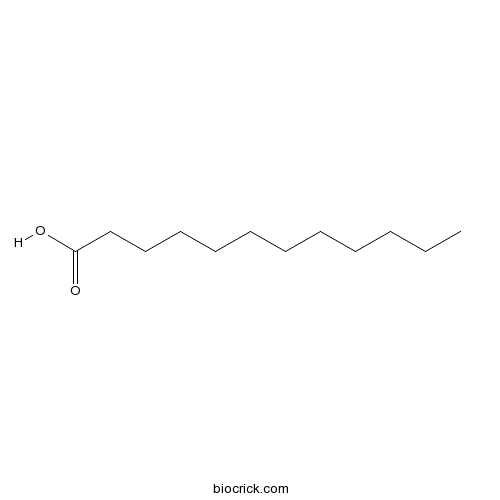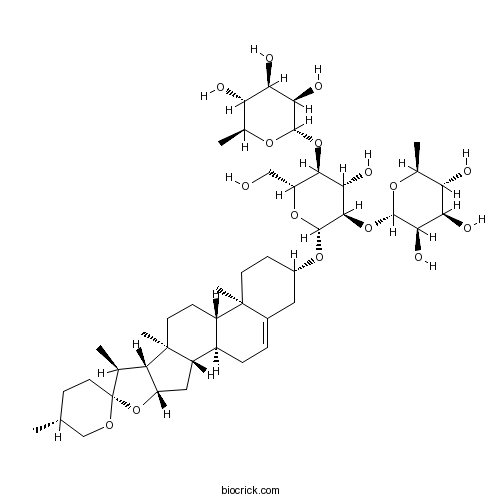Trachycarpus fortunei
Trachycarpus fortunei
1. The products in our compound library are selected from thousands of unique natural products; 2. It has the characteristics of diverse structure, diverse sources and wide coverage of activities; 3. Provide information on the activity of products from major journals, patents and research reports around the world, providing theoretical direction and research basis for further research and screening; 4. Free combination according to the type, source, target and disease of natural product; 5. The compound powder is placed in a covered tube and then discharged into a 10 x 10 cryostat; 6. Transport in ice pack or dry ice pack. Please store it at -20 °C as soon as possible after receiving the product, and use it as soon as possible after opening.
Natural products/compounds from Trachycarpus fortunei
- Cat.No. Product Name CAS Number COA
-
BCN2635
Lauric acid143-07-7
Instructions

-
BCN6273
Dioscin19057-60-4
Instructions

-
BCN5742
Mollugin55481-88-4
Instructions

-
BCN3820
Stearic Acid57-11-4
Instructions

Effect of N-Linked Glycosylation of Recombinant Windmill Palm Tree Peroxidase on Its Activity and Stability.[Pubmed: 29648454]
Plant secretory peroxidases are valuable commercial enzymes. The windmill palm tree Trachycarpus fortunei produces one of the most stable and fastest peroxidases (WPTP) characterized to date; however, an economical source is needed. Pichia pastoris has been used as an expression system for WPTP and other peroxidases. However, yeast and plants synthesize different types of N-linked glycan structures and may differ the level of glycosylation at each site. Such non-native glycosylation can have unwanted consequences. Glycosylation site N256 was under-glycosylated in the wild-type (1.5%) compared to the native enzyme (55%); therefore, we mutated WPTP to promote glycosylation at this site (WPTP E254G). Glycosylation increased four-fold, as measured by liquid chromatography-tandem mass spectrometry. The mutation did not change the substrate specificity and optimal pH- and thermo-stability ranges, but it increased the catalytic activity 2-3-fold. In comparison with wild-type WPTP, WPTP E254G showed a shift of the most stable pH from 7 to 9, making it suitable for applications under alkaline conditions.
Effects of Biodegradation on the Structure and Properties of Windmill Palm (Trachycarpus fortunei) Fibers Using Different Chemical Treatments.[Pubmed: 28772876]
In this work, windmill palm fiber (WPF), alkali-treated fiber (AF) without hemicellulose and bleached fiber (BF) without lignin were prepared and buried in soil for 30, 60 and 90 days. The surface morphology, chemical composition, crystallinity degree, mechanical properties, and residual mass rate of the samples, before and after biodegradation, were investigated. According to the results, soil burial degradation can remove the parenchyma cells and silica-bodies of WPF and deplete droplets containing the lignin of alkali-treated fiber after it has been buried for 30 days (AF30), and degradation of the single fiber cell wall of bleached fiber after it has been buried for 30 days (BF30). Buried in natural soil, lignin has a slower degradation rate than that of hemicellulose. WPF showed no significant differences in tensile strength after burial in soil for 90 days, because of the integrity fiber structure decreased the biodegradation. The most serious decrease, about 43%, in tensile strength occurred in AF after it had been buried for 90 days (BF90). This basic knowledge may be helpful for windmill palm fiber applications, especially for biodegradable composites.
Site-Specific N-Glycosylation Characterization of Windmill Palm Tree Peroxidase Using Novel Tools for Analysis of Plant Glycopeptide Mass Spectrometry Data.[Pubmed: 27151270]
Plant secretory (Class III) peroxidases are redox enzymes that rely on N-glycosylation for full enzyme activity and stability. Peroxidases from palm tree leaves comprise the most stable and active plant peroxidases characterized to date. Herein, site-specific glycosylation and microheterogeneity of windmill palm tree (Trachycarpus fortunei) peroxidase are reported. The workflow developed in this study includes novel tools, written in R, to aid plant glycan identification, pGlycoFilter, for annotation of glycopeptide fragmentation spectra, gPSMvalidator, and for relative quantitation of glycoforms, glycoRQ. Mass spectrometry analysis provided a detailed glycosylation profile at the 13 sites of N-linked glycosylation on windmill palm tree peroxidase. Glycan microheterogeneity was observed at each site. Site Asn211 was the most heterogeneous and contained 30 different glycans. Relative quantitation revealed 90% of each glycosylation site was occupied by three or fewer glycans, and two of the 13 sites were partially unoccupied. Although complex and hybrid glycans were identified, the majority of glycans were paucimannosidic, characteristic of plant vacuolar glycoproteins. Further studies pertaining to the glycan structure-activity relationships in plant peroxidases can benefit from the work outlined here.
Study on life parameters of the invasive species Octodonta nipae (Coleoptera: Chrysomelidae) on different palm species, under laboratory conditions.[Pubmed: 25195440]
In southeastern China, the invasion of the nipa palm hispid Octodonta nipae (Maulik) (Coleoptera: Chrysomelidae) results in devastating damage to palms. Host plants play an important role in the population increases and outbreaks of O. nipae. O. nipae could not complete its development on the Majestic palm (Ravenea rivularis Jumelle & Perrier), and females did not lay eggs on Chinese fan palm (Livistona chinensis R. Brown). However, this insect species both completed development and laid eggs on Chinese windmill palm (Trachycarpus fortunei (Hooker) H. Wendland), Canary Island date palm (Phoenix canariensis Chabaud), and pygmy date palm (Phoenix roebelenii O' Brien). The demographic characteristics of O. nipae reared on Chinese windmill palm, Canary Island date palm, and pygmy date palm were compared with an age-stage, two-sex life table. In this study, the developmental periods from egg to adult varied from 42.1 d on Chinese windmill palm to 49.8 d on pygmy date palm. The survivorship from egg to adult on Chinese windmill palm, Canary Island date palm, and pygmy date palm was 77.5, 79.4, and 66.7%, respectively. Although the adult longevity and the mean fecundity for individuals reared on Chinese windmill palm, Canary Island date palm, and pygmy date palm were not significantly different, there were significant differences in the intrinsic rate of increase, the finite rate, and the mean generation time among palm species, and the values of intrinsic rate of increase and finite rate were higher for populations reared on Chinese windmill palm and Canary Island date palm (0.0313 and 1.0318 d(-1) and 0.0278 and 1.0282 d(-1), respectively) and lower for populations reared on pygmy date palm (0.0192 and 1.0194 d(-1)). However, mean generation time was shorter on Chinese windmill palm (124.11 d) and Canary Island date palm (129.62 d) and longer on pygmy date palm (166.03 d). Our study indicated that different hosts affected life parameters of O. nipae, with the most preferred hosts being the Chinese windmill palm and Canary Island date palm. These results may be useful for the design of culture management strategies for O. nipae.
Evaluation of an oil dispersion formulation of imidacloprid as a drench against Rhynchophorus ferrugineus (Coleoptera, Curculionidae) in young palm trees.[Pubmed: 22262504]
The red palm weevil, Rhynchophorus ferrugineus (Olivier), is a phytophagous insect that feeds on soft succulent tissues of most palm species and is considered the main palm pest in the Middle East and the Mediterranean Basin. The aim of this study was to test the efficacy of imidacloprid oil dispersion (OD) as a drench in preventive and curative treatments against R. ferrugineus in Phoenix canariensis, Washingtonia robusta, Washingtonia filifera and Trachycarpus fortunei.
Purification and characterization of windmill palm tree (Trachycarpus fortunei) peroxidase.[Pubmed: 17177516]
High peroxidase activity was demonstrated to be present in the leaf of several species of cold-resistant palms. Histochemical studies of the leaf of windmill palm tree (Trachycarpus fortunei) showed the peroxidase activity to be localized in hypoderma, epidermis, cell walls, and conducting bundles. However, chlorophyll-containing mesophyll cells had no peroxidase at all. The leaf windmill palm tree peroxidase (WPTP) was purified to homogeneity and had a specific activity of 6230 units/mg, RZ = 3.0, a molecular mass of 50 kDa, and an isoelectric point of pI 3.5. The electronic spectrum of WPTP with a Soret band at 403 nm was typical of plant peroxidases. The N-terminal amino acid sequence of WPTP was determined. The substrate specificity of WPTP was distinct from that of other palm peroxidases, and the best substrate for WPTP was 2,2'-azinobis(3-ethylbenzthiazoline-6-sulfonic acid). The palm peroxidase showed an unusually high stability at elevated temperatures and high concentrations of guanidine.


